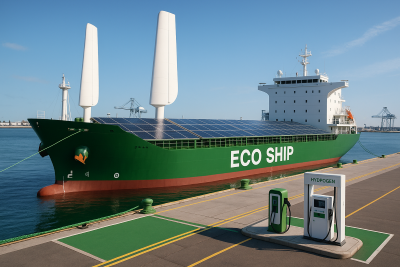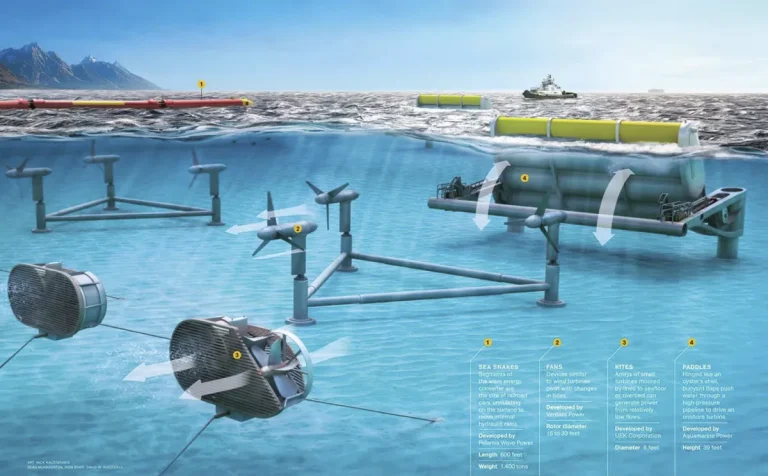Challenges in Scaling Marine Energy Technologies
Introduction
Marine energy, which includes technologies for harnessing wave, tidal, and ocean thermal energy, presents significant opportunities as a sustainable energy resource. As the world moves towards decarbonization and greener energy systems, the oceans represent a largely unexploited asset. Nevertheless, transitioning these technologies from experimental stages to large-scale commercial implementation encounters several major hurdles. These challenges encompass technical difficulties, substantial initial investments, environmental implications, and regulatory ambiguities.
In this article, we examine the key obstacles that impede the widespread adoption of marine energy technologies and investigate potential approaches to address them.
-
High Initial Investments and Economic Feasibility
One of the most urgent difficulties in expanding marine energy technologies is the considerable upfront costs associated with their development. The construction and deployment of marine energy systems demand significant funding for research, development, installation, and ongoing maintenance. These expenses are notably higher than those of more established renewable energy sources like wind or solar.
Additionally, the challenging marine environment accelerates deterioration, leading to higher operational and maintenance costs. As a result, the levelized cost of energy (LCoE) generated from marine sources remains comparatively elevated. Without adequate financial backing or long-term purchase agreements, investors may struggle to justify the associated risks.
Key elements contributing to elevated costs include:
- High-priced underwater infrastructure
- Challenges in transport and installation
- Limited economies of scale
- Requirement for specialized vessels and equipment
To tackle this issue, it is essential for governments and relevant stakeholders to invest in pilot initiatives and provide subsidies, tax benefits, or feed-in tariffs to promote commercial advancements.
-
Technological Development and Dependability
In contrast to wind or solar energy, marine energy technologies are still developing. Most current designs are either prototypes or in the early phases of commercialization, with many having not yet undergone testing in real-world conditions for prolonged durations. This lack of technological advancement presents a considerable barrier to scaling.
Moreover, marine environments are constantly changing and can be unpredictable. Devices need to endure saltwater corrosion, biofouling, and severe weather, all of which can jeopardize their performance and reliability. Thus, ensuring long-lasting durability and efficiency remains a critical challenge.
Current limitations include:
- Insufficient field data and operational experience
- Poor resilience during storm events
- Design inefficiencies resulting in less-than-optimal power generation
Despite these challenges, ongoing investment in research and development, coupled with international collaboration, can pave the way for more robust and dependable solutions.
-
Environmental and Ecological Issues
Although marine energy is environmentally friendly and renewable, it does carry certain ecological consequences. The installation and functioning of devices can impact local ecosystems, particularly affecting marine mammals, fish migration patterns, and seabed habitats.
Furthermore, underwater noise and electromagnetic fields produced by marine energy devices may disrupt marine organisms. As a result, securing environmental permits can be a lengthy and expensive undertaking.
Common ecological concerns include:
- Disruption of benthic ecosystems
- Potential harm to marine mammals and fish
- Alterations in sediment transport
- Possible changes to tidal currents
To alleviate these impacts, developers should conduct thorough Environmental Impact Assessments (EIAs) and adopt adaptive management strategies. Engaging with coastal communities and environmental organizations early in the process can also encourage public support.
-
Constraints in Regulatory Framework and in obtaining Permits
The regulatory framework governing marine energy is frequently characterized by fragmentation and ambiguity. In contrast to conventional energy sources, marine energy initiatives generally necessitate a multitude of permits from an array of governmental entities, specifically those tasked with environmental safeguarding, maritime safety, and energy infrastructure development.
Such complexity may precipitate delays, escalate expenses, and culminate in project cancellations. Additionally, the absence of standardized regulatory frameworks for marine energy constrains cross-border collaboration and the dissemination of best practices.
Challenges inherent within regulatory frameworks comprise:
- Protracted permitting durations
- Redundant jurisdictional authority
- Absence of explicit standards for marine energy
- Inadequate support from maritime spatial planning
To optimize procedural efficiency, it is imperative that governmental bodies formulate cohesive regulatory frameworks and allocate marine energy zones that have undergone pre-approval assessments. Such measures would substantially mitigate bureaucratic obstacles and promote expedited project implementation.
-
Grid Connectivity and Infrastructure
Even in instances where marine energy devices successfully produce electrical power, the transmission of said energy to terrestrial locations presents a significant challenge. Numerous promising marine energy sites are situated at considerable distances from existing grid infrastructure, particularly in isolated coastal or island locales.
The establishment of dependable grid connections necessitates considerable investment in subsea cabling, offshore substations, and interconnectors. Furthermore, the intermittent and fluctuating nature of wave and tidal energy introduces additional complexities in grid integration, necessitating advanced forecasting and energy storage solutions.
Principal infrastructure limitations encompass:
- Exorbitant costs associated with subsea cabling
- Concerns regarding grid stability attributable to variable energy output
- Limited options for energy storage
- Insufficient onshore infrastructure
Mitigating these challenges will require synergistic planning among energy developers, transmission operators, and governmental authorities. Moreover, the advancement of hybrid systems—such as the integration of marine energy with wind or solar technologies—can bolster reliability and enhance grid integration.
-
Restricted Financial Stake and Partial Business Involvement
Owing to the confluence of elevated costs, regulatory intricacies, and technical uncertainties, private investment in marine energy has remained comparatively limited. A considerable number of investors perceive marine energy as a high-risk venture, particularly when juxtaposed with more established renewable energy sources.
Consequently, commercial interest remains subdued, hindering the pace of innovation and deployment. Public funding and international collaborations currently represent the principal sources of financial support for the majority of marine energy initiatives.
Barriers to investment encompass:
- Indeterminate return on investment (ROI)
- Extended development timelines
- Lack of validated revenue models
- High perceived risk
Nonetheless, as technological advancements mature and successful case studies emerge, it is anticipated that investor confidence will increase. Initiatives such as public-private partnerships, innovation funds, and green bonds may also assume a critical role in attracting investment capital.
-
Public Recognition and Social Acceptance
Ultimately, the success of marine energy projects is inextricably linked to public endorsement. While the overarching perception of renewable energy tends to be favorable, localized opposition may still emerge due to apprehensions regarding visual aesthetics, environmental impact, or disruptions to traditional marine industries such as fishing and tourism.
In the absence of effective community engagement and transparent communication, marine energy projects may face delays, legal disputes, or even termination.
Public apprehensions typically center on:
- Transformations to coastal landscapes
- Potential repercussions on fisheries and marine navigation
- Limited awareness regarding the benefits of marine energy
To cultivate acceptance, it is imperative for developers to prioritize community engagement from the initial planning phase. The provision of economic incentives, the creation of employment opportunities, and the implementation of shared ownership frameworks can also foster trust and engender local backing.
Conclusion
Marine energy possesses the capacity to significantly contribute to the global transition towards sustainable energy systems. However, the process of advancing these technologies from prototype stages to commercially viable applications is beset with numerous challenges. These obstacles include elevated capital expenditures, technological immaturity, regulatory constraints, and environmental apprehensions, rendering the path forward intricate.
Nonetheless, through strategic investments, supportive policy frameworks, technological advancements, and collaborative stakeholder engagement, these challenges can be surmounted. By proactively addressing these matters, the marine energy sector has the potential to unveil new opportunities within the renewable energy landscape and make substantial contributions to a resilient and low-carbon future.
FAQs
- What factors contribute to the limited utilization of marine energy at present?
Marine energy remains in the nascent stages of development and contends with obstacles such as high costs, technical complexities, and regulatory impediments, which restrict its broader adoption.
- In what ways can governmental entities facilitate the scaling of marine energy?
Governments can provide financial incentives, streamline regulatory processes, invest in necessary infrastructure, and allocate funding for research and development to expedite the commercial rollout of marine energy technologies.
- Is marine energy considered environmentally sustainable?
While predominantly recognized as clean, marine energy has the potential to affect local ecosystems. Consequently, the implementation of mitigation strategies and comprehensive environmental assessments is vital to reduce adverse impacts.
- Which marine energy technologies are currently regarded as the most promising?
Tidal stream turbines, wave energy converters, and ocean thermal energy conversion systems are presently identified as some of the most promising technologies within this domain.



